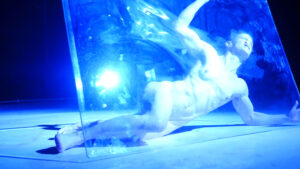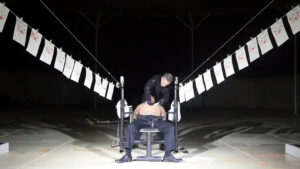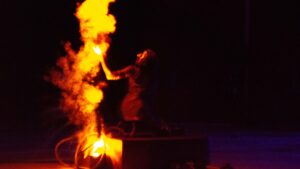“Cyclic: New Performance by Cassils, Ron Athey, and Fanaa in “Lung” of Biosphere 2
December 1, 2018 2:30 PM - 4:00 PM
Cyclic: New Performance by Cassils, Ron Athey, and Fanaa in “Lung” of Biosphere 2
Saturday, December 1, 2:30pm at Biosphere 2
$20 admission, includes access to Biosphere 2 Grounds and Tour
$75 VIP ticket includes pre-show cocktails and invite to private dance party with the artists in the home of 2 original Biospherians
Link to Vimeo: Filmed by Graham Kolbins, with funding from Canada Council
CYCLIC, A NEW PERFORMANCE BY RON ATHEY, CASSILS, AND FANAA PREMIERS IN THE “LUNG” OF BIOSPHERE 2 TO AN AUDIENCE OF 230
On December 1, 2018, The Museum of Contemporary Art (MOCA Tucson) presented Cyclic, a groundbreaking performance by renowned artists Cassils, Ron Athey and Fanaa to an international audience of over 230 attendees in the uniquely resonant “lung” of Biosphere 2, a site which simultaneously evokes utopian and dystopian possibilities. This new, collaborative work, presented in conjunction with the exhibition at MOCA Tucson “Blessed Be: Mysticism, Spirituality, and the Occult in Contemporary Art”, presented actions which highlighted the value of lives often deemed disposable, or even incomprehensible. Triangulated within a circle, alternately illuminated and concealed, the artists worked against light and dark, visibility and invisibility to bring their creative forces and subjectivities together in this performance that continuously unfolded in a triptych of tableaux vivants.
The performance began well before the physical actions of the artists; audience members were led into the “lung” in groups of ten in complete darkness, holding the shoulders of the individual in front of them. In total obscurity, attendees could only hear a soundscape designed by Kadet Khune entitled “Extinction”, consisting of sound samples of animals that have gone extinct since 1987, the year Biosphere 2 was built. After the full audience has been led in, well over 30 minutes have passed, building the suspense and anticipation of the performance. Slowly, a light shines in the middle, revealing Ron Athey and his assistant Hermes Pittakos performing a ritual sweeping of the space using a peacock feather broom and human compass rope system, gradually, unwinding a bound Athey while a roaming choral procession vocalizes around the outer perimeter of the space. Once unbound, Athey strides to a pre-drawn grid on the floor, where he re-imagines Brion Gysin’s 1960 recording (by Sean Griffin) of “Pistol Poem” using gun shot and vocal permutations of 1-5 on a grid, assisted by local performance artists Natalie Brewster Nguyen, Richard Michael Thompson, and Kris Aman.
Following this action, Ron Athey delivers a lecture, using text from Genesis P-Orridge’s Esoterrorist – Selected Essays 1980-1988. Athey is revealed with a single light, while up above on the steel ceiling of the lung the text scrolls slowly by.
——————-
“The myths and symbols of the past were attempts to articulate intimation of what is possible. The themes of mythology are not just archaic knowledge — they are living actualities of human beings.”
“In describing society, its behavior, its grandiose stupidity, we can be motivated by compassion and despair colored by not a little sarcasm and cynicism. Yet in every picture there is an enervation and texture that rely upon a resented CARING for its composition.”
“Framed by our paranoias, framed by conditioning, framed by false witness and the theft of all pieces of silver, we kiss the cheek of the land that bites us.”
‘We all die.’ ‘Well spoken,’ said the Sage to the wall, painting it white.”
———————-
Back in utter dark, a light slowly rises on a mound of earth Fanaa has been buried under for nearly an hour. As the sound of a subterranean drone unravels into a Palestinian lullaby by Rim Banna played in reverse, Fanaa is dragged out of the earth by two men, in an act somewhere between an exhumation and a birth. She gathers the earth of her burial into a large sack, struggling to drag it with her, invoking Medea’s action of carrying the soil of her homeland wherever she goes, as well as the guttural corporeality of Ana Mendieta’s Earth Body series.
The audience is again shrouded in darkness until their attention is drawn across the room, where a light shines on Cassils lying on the metal floor of the lung, the temperature of the room near freezing. One hundred pounds of thick, rectangular glass is placed on top of their prone body by two men. Cassils maneuvers the sheer weight of the material with controlled slow movement in order not to shatter the glass. The sonic conditions of the lung amplify every strained breath that utters from Cassils’ lips. The sound of scraping glass echoes disproportionately against the surface. Invoking the specimen, the “other”, surveillance, Cassils summons the ghosts of Ana Mendieta and Chris Burden. Playing with voyeurism, the frame, pressure and resistance, this action the artist calls “Pressed” speaks to the pressure of Visibility. The increasing representation of trans identity throughout art and popular culture in recent years has been nothing if not paradoxical. Trans visibility is touted as a sign of a liberal society, but it has coincided with a political moment marked both by heightened violence against trans people (especially trans women of color) and by the suppression of trans rights under civil law. “Pressed” explores this double-edged glass sword.
Black again. Lights slowly rise on a contraption that audience members have been wondering could possibly be the revival of Ron Athey’s iconic “The Human Printing Press” from his 1994 performance 4 Scenes in a Harsh Life. Ron is lead to a bench by his frequent collaborator Paul King, who performed this scene with Athey in the ‘90s. King binds Ron’s hands and two additional men attend to the action, the re-performance of which marks the 30th World AIDS Day. A scarification wound is made by King on Athey’s chest. Impressions of the wound, in blood, are “printed” on over 60 sheets of paper, suspended over the audience on two lines. The pattern cut is Dionysian, based on the stone Cretan symbol of the Minotaur.
While the lights go out on “The Human Printing Press”, Cassils and Hermes Pittakos disappear into the glowing gunk of UV reactive pools, emerging as the Minotaurs foretold in blood. Referencing the symbol of George Bataille and Andre Masson’s “Acephalous Man”, one is holding his guts, the other their heart.
In the center of the space, Fanaa—varnished in liquid gold—casts pulverized gold into the air behind her, becoming an alchemical fire. The action follows the soundscape of extinct animal screams that have been engulfed by industry with a series of glass-shattering screams, echoed in a call-and-response by the female- identifying members of the choir.
Listed by the Huffington Post as “one of ten transgender artists who are changing the landscape of contemporary art,” Cassils has achieved international recognition for a rigorous engagement with the body as a form of social sculpture. Featuring a series of bodies transformed by strict physical training regimens, Cassils’ artworks offer shared experiences for contemplating histories of violence, representation, struggle, and survival. Cassils juxtaposes the immediacy, urgency and ephemerality of live performance against constructed acts for camera. Bashing through binaries, Cassils’ transgender performances are not so much a crossing from one sex to another but rather a continual process of becoming, a form of embodiment that works in a space of indeterminacy, spasm, and slipperiness. Drawing on conceptualism, feminism, body art, and gay male aesthetics, Cassils forges a series of powerfully trained bodies for different performative purposes. It is with sweat, blood, and sinew that Cassils constructs a visual critique around ideologies and histories. Recent solo exhibitions include: Philadelphia Academy of Fine Arts; School of the Museum of Fine Arts Boston; Bemis Center, Omaha; MU Eindhoven, Netherlands; Trinty Square Video, Toronto; and Ronald Feldman Fine Arts, New York. Cassils’ work has also been featured as the key art for the blockbuster exhibition at the Deutsches Historisches Museum and the Schwules Museum; Berlin, Institute for Contemporary Art; The National Theatre, London; MUCA Roma, Mexico City; Yerba Buena Center for the Arts, San Francisco; Los Angeles Contemporary Exhibitions; Utah Museum of Contemporary Art, Salt Lake City; ANTI Contemporary Performance Festival, Kuopio, Finland; Museo da Imagem e do Som, São Paulo, Brazil; and the Museo de Arte y Diseño Contemporáneo, San José, Costa Rica. Cassils is the recipient of a United States Artists Fellowship (2018), Guggenheim Fellowship (2016), and a Creative Capital Award (2015). They have also received the inaugural ANTI Festival International Prize for Live Art, Rema Hort Mann Visual Arts Fellowship, California Community Foundation Grant, MOTHA (Museum of Transgender Hirstory) award, and Visual Artist Fellowship from the Canada Council of the Arts. Cassils’ work has been featured in New York Times, Boston Globe, Artfourm, Wired, The Guardian, TDR, Performance Research, Art Journal, and Vogue Brazil and was the subject of the monograph Cassils published by MU Eindhoven in 2015.
Los Angeles-based artist Ron Athey has been working at the vanguard of performance art for 25 years. Self-taught, his work developed out of post-punk/pre-goth scenes, and begins with Premature Ejaculation (PE), an early 1980s collaboration with Rozz Williams. Their approach to performance art was informed by the club actions of Johanna Went and the formulation of Industrial Culture (the idea of psycho/neuro acoustics in sound performance). Athey’s work often experiments with performing in a trance state, not unlike the Pentecostal spirit states he attained in his childhood religious experiences. In the 1990s, Athey formed a company of performers and made Torture Trilogy, a series of works that addressed the AIDS pandemic directly through memorializing and philosophical reflection. This work is characterized by the physical intensity of 1970s body-art canon (e.g. COUM Transmission, Carolee Schneeman and the Viennese Actionists). These performances toured internationally. The trilogy’s final chapter, Deliverance, was an Arts Council England commission and premiered at the ICA London. In the 2000s, Athey developed genre-stretching theatrical works like Joyce and The Judas Cradle, and a series of major solo performances such as The Solar Anus (which draws its name and spirit from a Georges Bataille essay, and from the action photographs of Pierre Molinier), Sebastiane (which plays with martyrology), Self-Obliteration Solo and Incorruptible Flesh (a series of solo performance that reflect on Athey’s collaborations with the late Lawrence Steger). In his most recent work, Gifts of the Spirit, Athey returns to his Pentecostal roots and expands his practice into performance anchored not by the artist’s body, but in his spirit.
Fanaa works across various mediums including film, visual art, performance, and sound, and is currently exploring themes of embodiment and mysticism, particularly within the Islamic Sufi context. Her body of work stems from the complexities of inhabiting multiple personas: woman, Muslim, immigrant, citizen, insider, and outsider. She challenges and celebrates the socio-cultural and religious iconography she was raised with, and works with the kaleidoscopic varieties of aesthetic expression in the Muslim world that are marginalized both within conservative Islam and the Western imagination. Her work is conceptualized in feminist modes without reference to the Western feminist model. She is the founder of Discostan, a collaborative decolonial project working with cultural production from the Middle East, North Africa, and South Asia. Narrative threads include migration, celebration, warfare, nostalgia, homeland, and borders, often within realms of Islamic influence, through lenses of traditional forms and kaleidoscopic reinventions of pop culture. Haq’s work has been featured at the Broad Museum, Toronto International Film Festival, MOMA New York, Hammer Museum, LAX Art, UC Irvine’s Global Visions Program, Centre Georges Pompidou, and the Pacific Film Archive. Currently, she hosts and produces monthly radio shows on Dublab and NTS featuring contemporary, traditional, and nostalgic music from across the MENASA region, and she recently released an album of Sufi field recordings from Pakistan on the Sublime Frequencies label.
ABOUT BIOSPHERE 2
Biosphere 2 is one of the world’s most unique facilities dedicated to the research and understanding of global scientific issues. With its five biomes and Landscape Evolution Observatory (LEO)—a large-scale controllable infrastructure consisting of three replicated artificial landscapes—Biosphere 2 is the
world’s largest earth science laboratory, providing the formerly missing link between Earth systems theory, experimentation and measurable outcomes. Biosphere 2 bridges traditional laboratory facilities and observational field research, providing opportunities for studies that can be done nowhere else on Earth.
The Biosphere 2 facility serves as a laboratory for controlled scientific studies, an arena for scientific discovery and discussion, and a far-reaching provider of public education. Its mission is to serve as a center for research, outreach, teaching and life-long learning about Earth, its living systems, and its place in the universe; to catalyze interdisciplinary thinking and understanding about Earth and its future; to be an adaptive tool for Earth education and outreach to industry, government, and the public; and to distill issues related to Earth systems planning and management for use by policymakers, students and the public.










